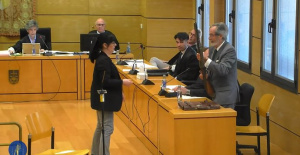MADRID, 24 May. (EUROPA PRESS) -
The General Director of Financial Stability, Regulation and Resolution of the Bank of Spain, Ángel Estrada, has pointed out that the widespread use of 'stablecoins' could imply structural risks in the medium term for financial stability as a result of the increase in interconnections between the financial market and the "erosion of the deposit-taking capacity of the banking sector".
During his speech at the 13th annual conference on Spanish capital markets, organized by the Association of Financial Markets in Europe (AFME), Estrada pointed out the main risks to financial stability, such as the increase in the price of raw materials and energy or the persistence of volatility derived from the pandemic, since the 'zero Covid' policy of some countries such as China could continue to generate bottlenecks in supply chains.
In addition to the macroeconomic risks, he has pointed to the uncertainties posed by the cryptoactive market, which includes both cryptocurrencies -- such as bitcoin -- and stablecoins, associated with stable assets such as fiat money or raw materials.
In this sense, he has called for the size of these markets and their interconnections to be taken into account. Thus, he pointed out that the cryptoactive market in Spain in 2021 accounted for 4.9% of GDP, a figure that is still "small, but has increased a lot compared to previous years", with an average annual increase of 20% in the last years.
Regarding the 'stablecoins', he has pointed out that these assets have more interconnections with the traditional financial system, which implies a risk for financial stability.
In fact, in the Financial Stability Report for 2021, the supervisor already warned that an increase between 'stablecoins' and the traditional financial market may imply "medium-term structural risks for financial stability through the erosion of the deposit-taking capacity of the banking sector, which would potentially alter the effects of monetary policy and condition capital flows".
Likewise, the report, published at the end of April, indicated that an increase in pressure to convert holdings of 'stablecoins' into legal tender "could lead to the hasty liquidation of positions in these products and generate liquidity tensions", among other risks.
However, Estrada has indicated that 'stablecoins' pose less risk than crypto assets, such as bitcoin, which do not have any assets to support their value. In addition to the volatility of these 'crypto' markets, Estrada has pointed out other risks linked to the lack of user protection against fraud, the opacity of this type of product or the lack of regulation, among others.

 Exploring Cardano: Inner Workings and Advantages of this Cryptocurrency
Exploring Cardano: Inner Workings and Advantages of this Cryptocurrency Seville.- Economy.- Innova.- STSA inaugurates its new painting and sealing hangar in San Pablo, for 18 million
Seville.- Economy.- Innova.- STSA inaugurates its new painting and sealing hangar in San Pablo, for 18 million Innova.- More than 300 volunteers join the Andalucía Compromiso Digital network in one month to facilitate access to ICT
Innova.- More than 300 volunteers join the Andalucía Compromiso Digital network in one month to facilitate access to ICT Innova.-AMP.- Ayesa acquires 51% of Sadiel, which will create new technological engineering products and expand markets
Innova.-AMP.- Ayesa acquires 51% of Sadiel, which will create new technological engineering products and expand markets The Ciudad Real Court sentences the man who killed a thief with two shots in his home to 6 years
The Ciudad Real Court sentences the man who killed a thief with two shots in his home to 6 years PP and PSOE clash in the Senate over Koldo's appearance after a socialist writing on a work plan
PP and PSOE clash in the Senate over Koldo's appearance after a socialist writing on a work plan FIFA and UEFA warn that "the protection and institutional stability of the RFEF must be prioritized"
FIFA and UEFA warn that "the protection and institutional stability of the RFEF must be prioritized" The parties close the Basque election campaign
The parties close the Basque election campaign How Blockchain in being used to shape the future
How Blockchain in being used to shape the future Not just BTC and ETH: Here Are Some More Interesting Coins Worth Focusing on
Not just BTC and ETH: Here Are Some More Interesting Coins Worth Focusing on Valencia displays its "innovative and technological potential" at the Emerge Americas event in Miami
Valencia displays its "innovative and technological potential" at the Emerge Americas event in Miami The CSIC incorporates the challenges of robotics, nanotechnology and AI in the new strategic plan for biomedicine
The CSIC incorporates the challenges of robotics, nanotechnology and AI in the new strategic plan for biomedicine Innovation allocates 9.1 million to train 74,000 people and guarantee digital inclusion
Innovation allocates 9.1 million to train 74,000 people and guarantee digital inclusion LIFE SPOT manages to develop new green treatments that eliminate groundwater contamination
LIFE SPOT manages to develop new green treatments that eliminate groundwater contamination A million people demonstrate in France against Macron's pension reform
A million people demonstrate in France against Macron's pension reform Russia launches several missiles against "critical infrastructure" in the city of Zaporizhia
Russia launches several missiles against "critical infrastructure" in the city of Zaporizhia A "procession" remembers the dead of the Calabria shipwreck as bodies continue to wash up on the shore
A "procession" remembers the dead of the Calabria shipwreck as bodies continue to wash up on the shore Prison sentences handed down for three prominent Hong Kong pro-democracy activists
Prison sentences handed down for three prominent Hong Kong pro-democracy activists ETH continues to leave trading platforms, Ethereum balance on exchanges lowest in 3 years
ETH continues to leave trading platforms, Ethereum balance on exchanges lowest in 3 years Investors invest $450 million in Consensys, Ethereum incubator now valued at $7 billion
Investors invest $450 million in Consensys, Ethereum incubator now valued at $7 billion Alchemy Integrates Ethereum L2 Product Starknet to Enhance Web3 Scalability at a Price 100x Lower Than L1 Fees
Alchemy Integrates Ethereum L2 Product Starknet to Enhance Web3 Scalability at a Price 100x Lower Than L1 Fees Mining Report: Bitcoin's Electricity Consumption Declines by 25% in Q1 2022
Mining Report: Bitcoin's Electricity Consumption Declines by 25% in Q1 2022 Oil-to-Bitcoin Mining Firm Crusoe Energy Systems Raised $505 Million
Oil-to-Bitcoin Mining Firm Crusoe Energy Systems Raised $505 Million Microbt reveals the latest Bitcoin mining rigs -- Machines produce up to 126 TH/s with custom 5nm chip design
Microbt reveals the latest Bitcoin mining rigs -- Machines produce up to 126 TH/s with custom 5nm chip design Bitcoin's Mining Difficulty Hits a Lifetime High, With More Than 90% of BTC Supply Issued
Bitcoin's Mining Difficulty Hits a Lifetime High, With More Than 90% of BTC Supply Issued The Biggest Movers are Near, EOS, and RUNE during Friday's Selloff
The Biggest Movers are Near, EOS, and RUNE during Friday's Selloff Global Markets Spooked by a Hawkish Fed and Covid, Stocks and Crypto Gain After Musk Buys Twitter
Global Markets Spooked by a Hawkish Fed and Covid, Stocks and Crypto Gain After Musk Buys Twitter Bitso to offset carbon emissions from the Trading Platform's ERC20, ETH, and BTC Transactions
Bitso to offset carbon emissions from the Trading Platform's ERC20, ETH, and BTC Transactions Draftkings Announces 2022 College Hoops NFT Selection for March Madness
Draftkings Announces 2022 College Hoops NFT Selection for March Madness


























